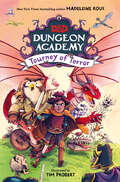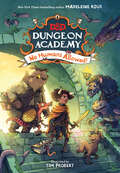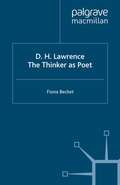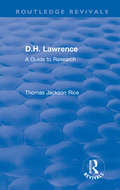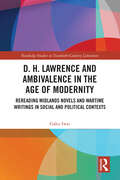- Table View
- List View
D&D Dungeon Academy 2
by Madeleine RouxWelcome to Dungeon Academy, where monsters and creatures train for the dark world that awaits just beyond the Dungeon walls.
D&D Dungeon Academy No Humans Allowed
by FarshoreWelcome to Dungeon Academy, where monsters and creatures train for the dark world that awaits just beyond the Dungeon walls.
The D.D. Warren Case Files (A Sampler): The Complete Collection of First Chapters
by Lisa GardnerDo you love NYT #1 Bestselling Lisa Gardner's brilliant novels? Have you never read her? Do you want to know more about her series and characters? Undeniably one of Lisa Gardner's greatest characters, D.D. Warren is smart, tough and stubborn to a fault. This exciting and thrilling introduction to the Detective D.D. Warren series features opening chapters from all seven novels in her series, including the latest, FEAR NOTHING - out now in ebook and in paperback on 10th October 2014. Heart-racing suspense and irresistible characters from the bestselling author of TOUCH & GO, CATCH ME, LOVE YOU MORE and many others.
D-Day: Storming Fortress Europe (Under Fire)
by Jack Chambers Erik Hendrix6 June, 1944: a vast armada stands off the coast of Normandy; in the pre-dawn gloom gliders carrying British airborne troops approach their target. The first shots are about to be fired in 'the Great Crusade' to free Europe from Nazi occupation and thousands of troops will fight their way ashore in the teeth of deadly machine-gun and artillery fire from the German defenders. D-Day is about to begin. The Normandy landings are brought alive in this electrifying graphic novel that tells the story of that Longest Day through the eyes of the men who were there. Discover an epic struggle as the Allies sought to overwhelm the German defenders by land, sea and air, who in turn battled desperately to drive the invasion back into the sea. Covering the full range of events from the earliest airborne assault through the struggle on the beaches and the desperate effort to establish a bridgehead inland, D-Day blends an authentic historical narrative with master illustration to reveal the full story of the day that changed the course of World War II.
D-Day: Storming Fortress Europe (Under Fire)
by Jack Chambers Erik Hendrix6 June, 1944: a vast armada stands off the coast of Normandy; in the pre-dawn gloom gliders carrying British airborne troops approach their target. The first shots are about to be fired in 'the Great Crusade' to free Europe from Nazi occupation and thousands of troops will fight their way ashore in the teeth of deadly machine-gun and artillery fire from the German defenders. D-Day is about to begin. The Normandy landings are brought alive in this electrifying graphic novel that tells the story of that Longest Day through the eyes of the men who were there. Discover an epic struggle as the Allies sought to overwhelm the German defenders by land, sea and air, who in turn battled desperately to drive the invasion back into the sea. Covering the full range of events from the earliest airborne assault through the struggle on the beaches and the desperate effort to establish a bridgehead inland, D-Day blends an authentic historical narrative with master illustration to reveal the full story of the day that changed the course of World War II.
D.G. Compton SF Gateway Omnibus: Synthajoy, The Steel Crocodile, Ascendancies (Sf Gateway Omnibuses Ser.)
by D.G. ComptonD.G. Compton is best known for his prescient 1974 novel, THE CONTINUOUS KATHERINE MORTENHOE, which predicted the 21st century's obsessions with media voyeurism and 'reality television'. It was filmed as DEATH WATCH in 1980 by Bertrand Tavernier. This omnibus collects three of his incisive SF novels, ASCENDANCIES, SYNTHAJOY and THE STEEL CROCODILE. ASCENDANCIES: Into a future where a depleted fuel supply had the world spiralling down into grinding poverty and constant war came ... Moondrift. Mysterious white flakes of alien matter that was the perfect fuel - clean, powerful, dependable. But the aliens - or whatever they were - who sent Moondrift seemed to demand a heavy ransom in return...SYNTHAJOY: Would you like to experience first-hand the emotions of a great artist, the sublime peace of a saint, the happiness of a child at Christmas? Try Sensitape. Or perhaps you had something more passionate in mind. Don't be shy. Ask for Sexitape. And for the true connoisseur, we have the ultimate human experience: a distinguished blend of synthetic ecstasies. The world is not ready for it, but perhaps you are. We call it Synthajoy.THE STEEL CROCODILE: In answer to an unanswerable future, science has created Bohn, the omnipotent computer whose flashing circuits and messianic pronouncements dictate what tomorrow will - or will not - be. But Matthew Oliver is flesh and blood and full of questions - not nearly as certain as the machine he's appointed to serve. And the right hand of science seldom knows what the left hand is doing...
D.H. Lawrence: The Thinker As Poet
by F. BecketD.H. Lawrence: The Thinker as Poet addresses a particular body of language and thought within Lawrence's oeuvre where the metaphorical, the poetic and the philosophical are intricately enmeshed. Lawrence emerges as a writer who pulls metaphor away from its merely rhetorical moorings: his distinctive style is the hallmark of one who thinks not analytically but poetically, about the birth of the self, the body unconscious, complex kinds of otherness and about metaphor itself as a mode of understanding.
D.H. Lawrence (Routledge Guides to Literature)
by Fiona BecketSo many questions surround the key figures in the English literary canon, but most books focus on one aspect of an author's life or work, or limit themselves to a single critical approach. D. H. Lawrence is a comprehensive, user-friendly guide which: * offers basic information on Lawrence's, contexts and works* outlines the major critical issues surrounding his works, from the time they were written to the present* explain the full range of often very different critical views and interpretation* offer guides to further reading in each area discussed. This guidebook has a broad focus but one very clear aim: to equip you with all the knowledge you need to make your own new readings of the work of D. H. Lawrence.
D.H. Lawrence (Routledge Guides to Literature)
by Fiona BecketSo many questions surround the key figures in the English literary canon, but most books focus on one aspect of an author's life or work, or limit themselves to a single critical approach. D. H. Lawrence is a comprehensive, user-friendly guide which: * offers basic information on Lawrence's, contexts and works* outlines the major critical issues surrounding his works, from the time they were written to the present* explain the full range of often very different critical views and interpretation* offer guides to further reading in each area discussed. This guidebook has a broad focus but one very clear aim: to equip you with all the knowledge you need to make your own new readings of the work of D. H. Lawrence.
D. H. Lawrence: Nature, Narrative, Art, Identity
by J. BeerA full account of Lawrence, ranging from his talent as a young writer to the continuing genius of his later work, and concentrating on his exceptionally acute powers of observation, both human and natural.
D. H. Lawrence: Sons And Lovers:essays On Japanese History And Politics (pdf) (Author Chronologies Series)
by R. P. DraperD.H. Lawrence: The Utopian Vision
by Eugene GoodheartThe dominant view of D.H. Lawrence's work has long been that of F. R. Leavis, who confined Lawrence within an exclusively ethical and artistic tradition. In D.H. Lawrence: The Utopian Vision, Eugene Goodheart widens the context in which Lawrence should be understood to include European as well as English writers - Blake, Nietzsche, Rilke, and Freud among others. Goodheart shows that the characteristic impulse of Lawrence's principal discovery was the bodily or physical life that he believed man had once possessed in his pre-civilized past and must now fully recover if future civilized life is possible. Goodheart's argument fully engages the paradoxes of Lawrence's writing. He is at once the last great representative of the moral tradition of the English novel and of the English Protestant imagination and a novelist without precedent, a diabolist in the service of the dark gods. He rejects the claims of society, while simultaneously lamenting the thwarting of the societal instinct. The oppositions and paradoxes in the work are the expression of a single, not always coherent, revolutionary imagination. D.H. Lawrence: The Utopian Vision provides a rigorous and critical analysis of the ideological character of Lawrence's novels and essays, in particular the effect of his utopianism on his views of nature, myth, and religious experience, while responding to his aesthetic achievement. Goodheart's Lawrence is a prophetic artist whose vision is at once inspiring and dangerous. In the new introduction to the book, Goodheart reflects upon the vicissitudes of Lawrence's reputation since the sixties when the book first appeared and his relevance to the concerns of our own time.
D.H. Lawrence: The Utopian Vision
by Eugene GoodheartThe dominant view of D.H. Lawrence's work has long been that of F. R. Leavis, who confined Lawrence within an exclusively ethical and artistic tradition. In D.H. Lawrence: The Utopian Vision, Eugene Goodheart widens the context in which Lawrence should be understood to include European as well as English writers - Blake, Nietzsche, Rilke, and Freud among others. Goodheart shows that the characteristic impulse of Lawrence's principal discovery was the bodily or physical life that he believed man had once possessed in his pre-civilized past and must now fully recover if future civilized life is possible. Goodheart's argument fully engages the paradoxes of Lawrence's writing. He is at once the last great representative of the moral tradition of the English novel and of the English Protestant imagination and a novelist without precedent, a diabolist in the service of the dark gods. He rejects the claims of society, while simultaneously lamenting the thwarting of the societal instinct. The oppositions and paradoxes in the work are the expression of a single, not always coherent, revolutionary imagination. D.H. Lawrence: The Utopian Vision provides a rigorous and critical analysis of the ideological character of Lawrence's novels and essays, in particular the effect of his utopianism on his views of nature, myth, and religious experience, while responding to his aesthetic achievement. Goodheart's Lawrence is a prophetic artist whose vision is at once inspiring and dangerous. In the new introduction to the book, Goodheart reflects upon the vicissitudes of Lawrence's reputation since the sixties when the book first appeared and his relevance to the concerns of our own time.
D. H. Lawrence: A Reference Companion
by Paul PoplawskiD.H. Lawrence remains one of the most popular and studied authors of the 20th century. This book is a comprehensive but easy to use reference guide to Lawrence's life, works, and critical reception. The volume has been systematically structured to convey a coherent overall sense of Lawrence's achievement and critical reputation, but it is also designed to enable the reader who may be interested in only one aspect of Lawrence's career, perhaps even in only one of his novels or stories, to find relevant information quickly and easily without having to read other parts of the text.The book begins with an original biography by John Worthen, one of the world's foremost authorities on Lawrence's life and work. The chapters that follow provide separate entries for all of Lawrence's works, except for individual poems and paintings, with critical summaries, discussions of characters, and details of settings. There is also a complete overview of Lawrence and film, with the most complete listing available of film adaptations of his works and of criticism relating to them. Each section of the book provides comprehensive primary and secondary bibliographical data, including citations for the most recent scholarly studies. Maps and chronologies further trace Lawrence's travels and his development over time.
D.H. Lawrence: A Guide to Research (Routledge Revivals)
by Thomas Jackson RiceOriginally published in 1983, D.H. Lawrence is an annotated bibliographic collection of works by and about D.H. Lawrence. Consisting of three parts, the primary bibliography contains separate bibliographies of Lawrence’s major publications, of collection editions of his works, of his letters, and of concordances to his writings. The secondary bibliography contains bibliographies of biographical and critical publications concerning Lawrence, generally or his individual works. Appendixes and Indexes include an extensive checklist of major foreign-language publications concerning Lawrence and a useful topical and thematic subject index for the guide.
D.H. Lawrence: A Guide to Research (Routledge Revivals)
by Thomas Jackson RiceOriginally published in 1983, D.H. Lawrence is an annotated bibliographic collection of works by and about D.H. Lawrence. Consisting of three parts, the primary bibliography contains separate bibliographies of Lawrence’s major publications, of collection editions of his works, of his letters, and of concordances to his writings. The secondary bibliography contains bibliographies of biographical and critical publications concerning Lawrence, generally or his individual works. Appendixes and Indexes include an extensive checklist of major foreign-language publications concerning Lawrence and a useful topical and thematic subject index for the guide.
D.H. Lawrence: A Literary Life (Literary Lives)
by John WorthenLawrence's career as a professional writer is a remarkable story. The son of a coal-miner, he made a moderately successful start to his professional life in 1912; but the banning of his novel The Rainbow in 1915 effectively destroyed his capacity to earn his living by his writing during the War. Even after the War, he wrote an enormous amount in many genres not simply because he was a creative genius, but because his books generally sold so poorly; only Lady Chatterley's Lover ever earned him very much. This study not only describes his day-to-day achievement as a professional writer, but also the problems which influenced his writing.
D. H. Lawrence and Ambivalence in the Age of Modernity: Rereading Midlands Novels and Wartime Writings in Social and Political Contexts (Routledge Studies in Twentieth-Century Literature)
by Gaku IwaiD. H. Lawrence is renowned for his scathing criticism of the ruling class, industrialisation of the country and wartime patriotism. However, his texts bear the imprint of contemporary dominant ideologies and discourses of the period. Comparing Lawrence’s texts to various major and minor contemporary novels, journal articles, political pamphlets and history books, this book aims to demonstrate that Lawrence’s texts are ambivalent: his texts harbour the dynamism of conflicting power struggles between the subversive and the reactionary. For example, in some apparently apolitical texts such as The White Peacock and Movements in European History, reactionary ideologies and wartime propaganda are embedded. Some texts like Lady Chatterley’s Lover are intended to be a radical critique of the period wherein it was composed, but they also bear discernible traces of the contemporary frame of reference that they intend to subvert. Focusing on Lawrence’s stories and novels set in the mining countryside and the works composed under the impact of the First World War, this book establishes that Lawrence’s texts in fact consist of multiple layers that are often in conflict with each other, serving as a testimony to the age of modernity.
D. H. Lawrence and Ambivalence in the Age of Modernity: Rereading Midlands Novels and Wartime Writings in Social and Political Contexts (Routledge Studies in Twentieth-Century Literature)
by Gaku IwaiD. H. Lawrence is renowned for his scathing criticism of the ruling class, industrialisation of the country and wartime patriotism. However, his texts bear the imprint of contemporary dominant ideologies and discourses of the period. Comparing Lawrence’s texts to various major and minor contemporary novels, journal articles, political pamphlets and history books, this book aims to demonstrate that Lawrence’s texts are ambivalent: his texts harbour the dynamism of conflicting power struggles between the subversive and the reactionary. For example, in some apparently apolitical texts such as The White Peacock and Movements in European History, reactionary ideologies and wartime propaganda are embedded. Some texts like Lady Chatterley’s Lover are intended to be a radical critique of the period wherein it was composed, but they also bear discernible traces of the contemporary frame of reference that they intend to subvert. Focusing on Lawrence’s stories and novels set in the mining countryside and the works composed under the impact of the First World War, this book establishes that Lawrence’s texts in fact consist of multiple layers that are often in conflict with each other, serving as a testimony to the age of modernity.
D. H. Lawrence and Feminism (Routledge Revivals)
by Hilary SimpsonFirst published in 1982, D. H. Lawrence and Feminism discusses Lawrence’s work by examining it in relation to aspects of women’s history and the development of feminism. Two different modes of pre-war feminism which provide important themes in Lawrence’s early writings are examined in the opening chapters. The central chapters deal with the war, both as a catalyst for major changes in the position of women and as a point of no return in the development of Lawrence’s work. A final chapter looks at the way in which Lawrence used women as collaborator, and their writing as source material. This book will be of interest to students of literature, women’s studies and history.
D. H. Lawrence and Feminism (Routledge Revivals)
by Hilary SimpsonFirst published in 1982, D. H. Lawrence and Feminism discusses Lawrence’s work by examining it in relation to aspects of women’s history and the development of feminism. Two different modes of pre-war feminism which provide important themes in Lawrence’s early writings are examined in the opening chapters. The central chapters deal with the war, both as a catalyst for major changes in the position of women and as a point of no return in the development of Lawrence’s work. A final chapter looks at the way in which Lawrence used women as collaborator, and their writing as source material. This book will be of interest to students of literature, women’s studies and history.
D. H. Lawrence and the Authoritarian Personality
by Barbara MenschA documentation of D.H.Lawrence's insight into and portrayal of the destruction of self and society inherent in authoritarianism. The author begins her study with detailed definitions of the operative terms upon which the book based - fascism, authoritarianism and totalitarianism.
